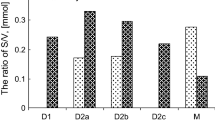Summary.
The nature and specificity of the Wiesner test (phloroglucinol-HCl reagent) for the aromatic aldehyde fraction contained in lignins is studied. Phloroglucinol reacted in ethanol-hydrochloric acid with coniferyl aldehyde, sinapyl aldehyde, vanillin, and syringaldehyde to yield either pink pigments (in the case of hydroxycinnamyl aldehydes) or red-brown pigments (in the case of hydroxybenzaldehydes). However, coniferyl alcohol, sinapyl alcohol, and highly condensed dehydrogenation polymers derived from these cinnamyl alcohols and aldehydes did not react with phloroglucinol in ethanol-hydrochloric acid. The differences in the reactivity of phloroglucinol with hydroxycinnamyl aldehydes and their dehydrogenation polymers may be explained by the fact that, in the latter, the unsubstituted (α,β-unsaturated) cinnamaldehyde functional group, which is responsible for the dye reaction, is lost due to lateral chain cross-linking reactions involving the β carbon. Fourier transform infrared spectroscopy and thioacidolysis analyses of phloroglucinol-positive lignifying plant cell walls belonging to the plant species Zinnia elegans L., Capsicum annuum var. annuum, Populus alba L., and Pinus halepensis L. demonstrated the presence of 4-O-linked hydroxycinnamyl aldehyde end groups and 4-O-linked 4-hydroxy-3-methoxy-benzaldehyde (vanillin) end groups in lignins. However, given the relatively low abundance of 4-O-linked vanillin in lignifying cell walls and the low extinction coefficient of its red-brown phloroglucinol adduct, it is unlikely that vanillin contributes to a great extent to the phloroglucinol-positive stain reaction. These results suggest that the phloroglucinol-HCl pink stain of lignifying xylem cell walls actually reveals the 4-O-linked hydroxycinnamyl aldehyde structures contained in lignins. Histochemical studies showed that these aldehyde structures are assembled, as in the case of coniferyl aldehyde, during the early stages of xylem cell wall lignification.
Similar content being viewed by others
Author information
Authors and Affiliations
Additional information
Received April 17, 2002; accepted May 21, 2002; published online October 31, 2002
RID="*"
ID="*" Correspondence and reprints: Department of Plant Biology, University of Murcia, 30100 Murcia, Spain.
Abbreviations: DHP dehydrogenation polymers; FT-IR spectroscopy Fourier transform infrared spectroscopy.
Rights and permissions
About this article
Cite this article
Pomar, F., Merino, F. & Barceló, A. O-4-Linked coniferyl and sinapyl aldehydes in lignifying cell walls are the main targets of the Wiesner (phloroglucinol-HCl) reaction. Protoplasma 220, 0017–0028 (2002). https://doi.org/10.1007/s00709-002-0030-y
Issue Date:
DOI: https://doi.org/10.1007/s00709-002-0030-y




